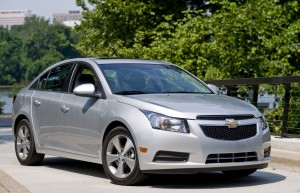Less than three years after emerging from bankruptcy General Motors is positioned to once again be the world’s number one automaker, with sales for 2011 totaling 9.03 million. Its largest brand Chevrolet, meanwhile, reported an all-time record of 4.76 million sales to close out its 100th anniversary.
GM’s victory celebration will have to wait for Toyota to confirm its 2011 numbers. The Japanese giant had toppled its U.S. rival as global king-of-the-hill three years ago but it lost 100s of thousands of units of production in 2011 due to the impact of the March 11 Japanese earthquake and tsunami.
For the first three quarters of last year, Toyota deliveries were off 8.8%, to 5.77 million, and though it had hoped to pick up lost momentum in the fourth quarter its plans were again set back by subsequent flooding in Thailand. Preliminary figures suggest it will end 2011 with 7.9 million sales, down about 6% for the full year.
That is likely to mean that Volkswagen AG will squeak into second place, with total sales of 8.39 million for the year. The German maker has set a goal of global sales leadership, however, by 2018.
Why VW wants to get there is a question analyst Aaron Bragman, of IHS Automotive, says he doesn’t fully understand. It gets you bragging rights, the analyst says, “But that’s about it. Being biggest in the world is not necessarily an advantage to anyone. GM was number one for something like 75 years and then went into bankruptcy.”
What is “far more important,” Bragman cautions, “is sustainable profitability.”
That’s not to say size doesn’t matter. Bigger volume translates into greater economies of scale, which is why the top three makers – as well as rivals like Fiat/Chrysler and Nissan – push for volume. In some cases, a manufacturer can sidestep the need to drive up its own sales by entering into alliances or joint ventures. Nissan, for example, has a close partnership with France’s Renault, while it has also been expanding a series of joint ventures with Germany’s Daimler – the two announcing this month plans to jointly produce engines at a plant in Decherd, Tennessee.
Excluding Daimler, the Renault-Nissan Alliance also appears to be positioned to push past Toyota, with sales of 8.03 million likely to move it into third place for 2011.
Nonetheless, the latest industry sales numbers can’t simply be dismissed. For GM, they symbolize a significant recovery since the maker lost the sales crown shortly before having to enter Chapter 11 protection.
In particular, the tally underscores the U.S. maker’s increasing focus on markets outside of its traditional hub in North America. Nearly three out of four GM vehicles were sold, last year, in markets ranging from China to the Czech Republic.
And a growing number of them wore the Chevrolet badge. Chevy has traditionally been the largest of the GM brands but, until recently, it focused on the Americas, leaving the rest of the world to German-based Opel (and, in China, to Buick). In recent years, GM has been downplaying the troubled Opel and turning to Chevrolet to do the global heavy lifting. Much of its growth has been organic, but in 2011 GM abandoned the Daewoo nameplate and rebadged the Korean brand’s products as Chevys.
While foreign sales typically don’t generate the revenues and margins of products sold in the U.S., GM saw its earnings during just the first nine months of 2011 surge to $8.47 billion, up from $6.17 billion in 2010. The maker had lost tens of billions in the years leading up to its bankruptcy.
As for Toyota, the Japanese automaker has laid out its own aggressive goals, but the push to reach 10 million sales annually will likely be delayed by several years, at the least, analysts caution.
In fact, Bragman believes Toyota could find it much more difficult to regain the industry lead than it has indicated.
“I don’t buy into the idea they’ll come roaring back,” he said. “They’re going to have a fight on their hands” as GM pushes to maintain its momentum while VW marches forward in its own bid for world domination.

